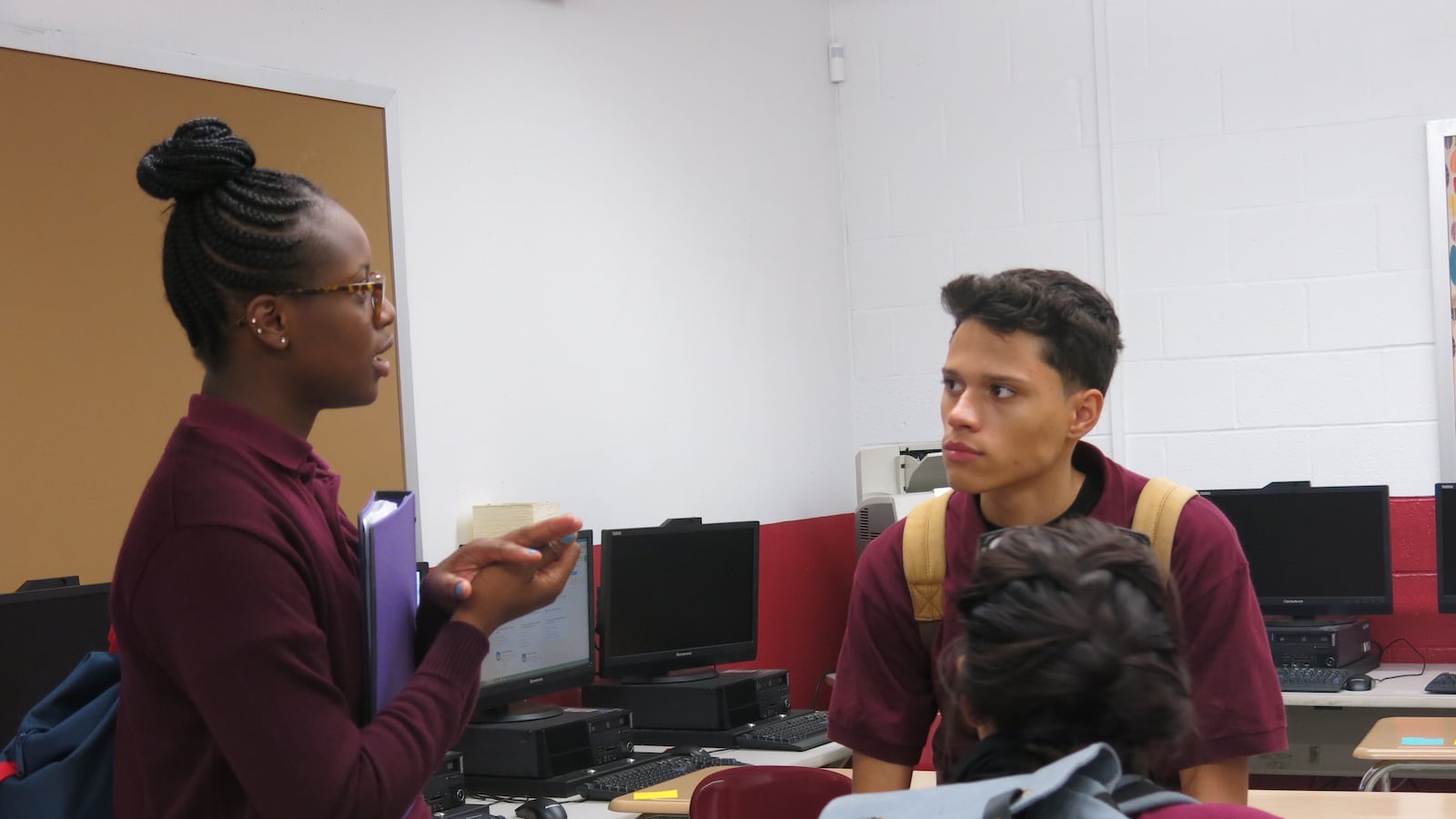After her homework assignment, 17-year-old Leslie Sigaran would refer to it only as “that thing you made us hear.”
“It” was a podcast detailing a school integration effort near Ferguson, Missouri. Teacher Sarah Camiscoli played the audio again during class at the Urban Assembly Bronx Academy of Letters earlier this year. As they listened, the students around Sigaran angrily shook their heads.
“They make race and ethnicity sound like animals instead of people,” one student said.
“You can tell she’s only heard stereotypes,” another chimed in, referring to a Missouri mother who called for metal detectors.
“They don’t see what they do to people,” said another.
The discussion happened in an elective class Camiscoli focused on school integration. The class is designed to take an issue relevant to South Bronx students and explain it using history and current events.
“Students are pretty clear on the fact that there are things that they want to transform,” Camiscoli said. The problem, she said, is that they often lack the terminology or historical context to articulate solutions.
The class’s loftier goal is to give these students a voice in the ongoing public discussion about race and New York City schools. That debate has intensified this year, as New York’s schools were named among the most segregated in the nation. But those conversations rarely involve high schoolers from the South Bronx.
Camiscoli’s students are trying to change that. Among other activities, the class will present findings at relevant council meetings and make a documentary with alumni of the Columbia Journalism School.
These students believe they have something important to add. Armed with an intuitive understanding of inequity, students want policymakers to change school segregation while respecting their deep loyalties to their school and community.
“We’re revolutionizing and starting a movement and changing things,” Amina Fofana, a junior, said.
In many ways, Camiscoli’s classroom is an unlikely setting for this discussion.
Her high school, known as Bronx Letters, is located in District 7 in the South Bronx, an area that exemplifies many of the roadblocks to creating diverse schools. The district has few, if any, affluent residents. Bronx Letters is unscreened and gives admissions preference to students from the Bronx, the city’s poorest borough. The student body is almost exclusively black and Hispanic, and 94 percent of students live in poverty.
Still, Bronx Letters is a high school, which means students from across the city can choose it. The school is small, with just over 600 students in both the middle and high school and and partners with the Urban Assembly, a nonprofit designed to help students prepare for success after high school.
For some students, segregation was crystallized last year when they took a trip, organized by Camiscoli, to a high school on the Upper East Side. Camiscoli dubbed the trip the “6 Train Exchange,” because the two schools are separated by only a few subway stops.
Samantha Ramos and Britney Soto were dazzled by the art, music, and technology available at the school on the Upper East Side. During one class students just “whipped out their violins,” Ramos said. In another, she said, students worked with pottery.
The class strives to add context to these moments, connecting students’ experiences to housing segregation and explanations of how schools are funded. The class will also study how different parts of the country have addressed school segregation. Ultimately, Camiscoli hopes students will have the skills necessary to help shape policy.
“We need to think about new solutions for the Bronx,” she said.
None of this is to say that students at Bronx Letters dislike their school. In fact, they are the first to defend it.
“It’s not about making ourselves look better, ‘cause honestly I don’t care what other people think,” Leslie said. “I would like other people to realize that just because the school’s in the Bronx and we don’t have resources doesn’t mean it’s not a good school.”
Earlier this year, students had yet to discuss the “how” of school integration. But the students shared a strong conviction that no solution should require them to abandon their Bronx school.
The mantra they repeated was: “Don’t move. Improve.”’
For Christian Rivera, that means helping students in all schools get computers with updated technology, more textbooks, and larger classrooms with space to study.
For Fofana, the goal is to help students of different races and backgrounds see the same potential she sees in her own school.
“Mostly I think it’s more important that students want, from other ethnicities, to come here,” she said. “White students shouldn’t be afraid to walk into a black school and be like ‘they’re dangerous’ or ‘they’re violent,’ cause we’re not.”
Though students are still learning how to accomplish these goals, the class is designed to transform convictions into action.
“This is about developing student advocacy skills,” said Brandon Cardet-Hernandez, the principal of the school. “Segregation gets to be the focus of how we’re thinking and learning about how we are agents of change.”

